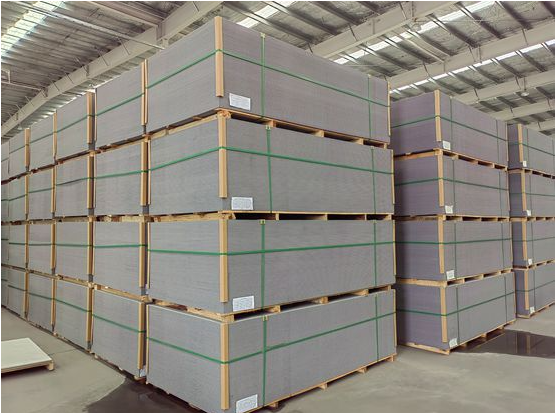What is a Fiber Cement Board?
Fiber cement board is a composite building material made of cement, cellulose fibers, sand, and water, processed under high pressure and temperature to form rigid, durable, and weather-resistant panels. Known for its exceptional strength, moisture resistance, and non-combustible nature, fiber cement board is a preferred choice in modern construction for both interior and exterior applications.
Unlike gypsum or plywood, fiber cement board does not rot, swell, or warp when exposed to moisture, making it ideal for high-humidity areas, exterior cladding, wet rooms, and fire-rated assemblies.

Key Features of Fiber Cement Board
1. Moisture Resistance
Fiber cement boards resist water absorption and are not prone to swelling, delamination, or decay. They are ideal for:
Bathrooms
Kitchens
Laundry rooms
Exterior wall sidings
2. Fire Resistance
These boards are non-combustible (Class A fire rating) and provide excellent fire barrier properties. Fiber cement will not ignite or contribute to fire spread, making it suitable for fire-rated partitions, facades, and ceilings.
3. Termite and Fungal Resistance
Since the boards contain no organic matter, they do not support the growth of mold, mildew, or attract termites, unlike wood-based materials.
4. Dimensional Stability
Fiber cement maintains its shape and size even in changing climates and extreme temperatures, providing a long-term solution for both interiors and exteriors.
5. High Impact Strength
The composition ensures resistance to dents and physical wear, making it suitable for high-traffic areas and public infrastructure.
Applications of Fiber Cement Boards
Exterior Applications
Wall Cladding: Used as a durable and weatherproof façade, fiber cement panels can be painted or textured to match architectural aesthetics.
Eaves and Soffits: Lightweight and fire-resistant, ideal for under-roof installations.
Weather Barriers: Acts as a substrate layer behind cladding systems to improve building envelope performance.
Interior Applications
Drywall Replacement: An alternative to gypsum board in wet areas or where extra strength is needed.
Ceilings and Partitions: Used in offices, malls, schools, and hospitals due to its fire-retardant and soundproofing capabilities.
Floor Underlayment: Acts as a stable base layer for tiles in wet environments like bathrooms.
Industrial and Commercial Applications
Types of Fiber Cement Boards
1. Standard Fiber Cement Board
Used for basic construction needs like wall linings, ceilings, and eaves. Generally available in plain or lightly textured finishes.
2. High-Density Fiber Cement Board
Heavier and tougher, designed for external cladding, flooring substrates, and areas subject to impact or mechanical stress.
3. Decorative or Pre-Finished Fiber Cement Panels
Come pre-painted, textured, or coated, offering ready-to-install options that save time and labor on-site.
Technical Specifications
| Property | Standard Value |
| Thickness Range | 4mm – 20mm |
| Density | 1300 – 1800 kg/m³ |
| Fire Rating | Class A (ASTM E84) |
| Flexural Strength | 9 – 15 MPa |
| Water Absorption | < 30% |
| Thermal Conductivity | ~0.20 W/m·K |
Fiber cement boards are generally available in 4' x 8' (1220 x 2440 mm) panels and can be cut, drilled, nailed, or screwed using standard carbide tools.
Advantages Over Other Materials
| Material | Water Resistance | Fire Resistance | Durability | Maintenance |
| Fiber Cement Board | Excellent | Excellent | Very High | Low |
| Gypsum Board | Poor | Fair | Moderate | Medium |
| Plywood | Poor | Poor | Moderate | High |
| Calcium Silicate Board | Good | Excellent | High | Medium |
Fiber cement board outperforms most common construction boards in resistance, longevity, and versatility, offering an excellent cost-performance ratio.
Installation Guidelines
Use galvanized screws or nails for fixing.
Maintain a gap of 3–5 mm between panels to allow for expansion.
Apply joint sealant or PU foam for waterproofing exterior applications.
Prime and paint the board using alkali-resistant primers and UV-stable topcoats for extended life.
Environmental and Health Benefits
Low VOC emissions
Asbestos-free and formaldehyde-free
Recyclable and safe for indoor use
Durable lifespan reduces waste generation
Many manufacturers now offer green-certified products that comply with LEED, WELL, and other sustainable construction standards.
Conclusion: A High-Performance Panel for Modern Construction
Fiber cement board is a versatile, safe, and long-lasting building material that meets the rigorous demands of contemporary architecture. It offers unmatched performance in wet, fire-prone, and impact-prone environments, making it a preferred choice for engineers, architects, and builders across residential, commercial, and industrial sectors.
Whether you're renovating a kitchen, designing a hospital, or constructing an energy-efficient façade, fiber cement boards deliver strength, safety, and sustainability with every panel.
English
العربية
Français
Русский
Español
Português
Deutsch
italiano
日本語
한국어
Nederlands
Tiếng Việt
ไทย
Polski
Türkçe
አማርኛ
Bahasa Melayu
தமிழ்
Filipino
Bahasa Indonesia
magyar
Română
Монгол
қазақ
Српски
हिन्दी
فارسی
Kiswahili
Slovenčina
Slovenščina
Svenska
українська
Ελληνικά
Suomi
Հայերեն
עברית
اردو
Shqip
বাংলা
Hrvatski
Afrikaans
Māori
සිංහල
Oʻzbekcha
latviešu
Беларуская мова
Bosanski
Български
ქართული
Lietuvių
Malti







